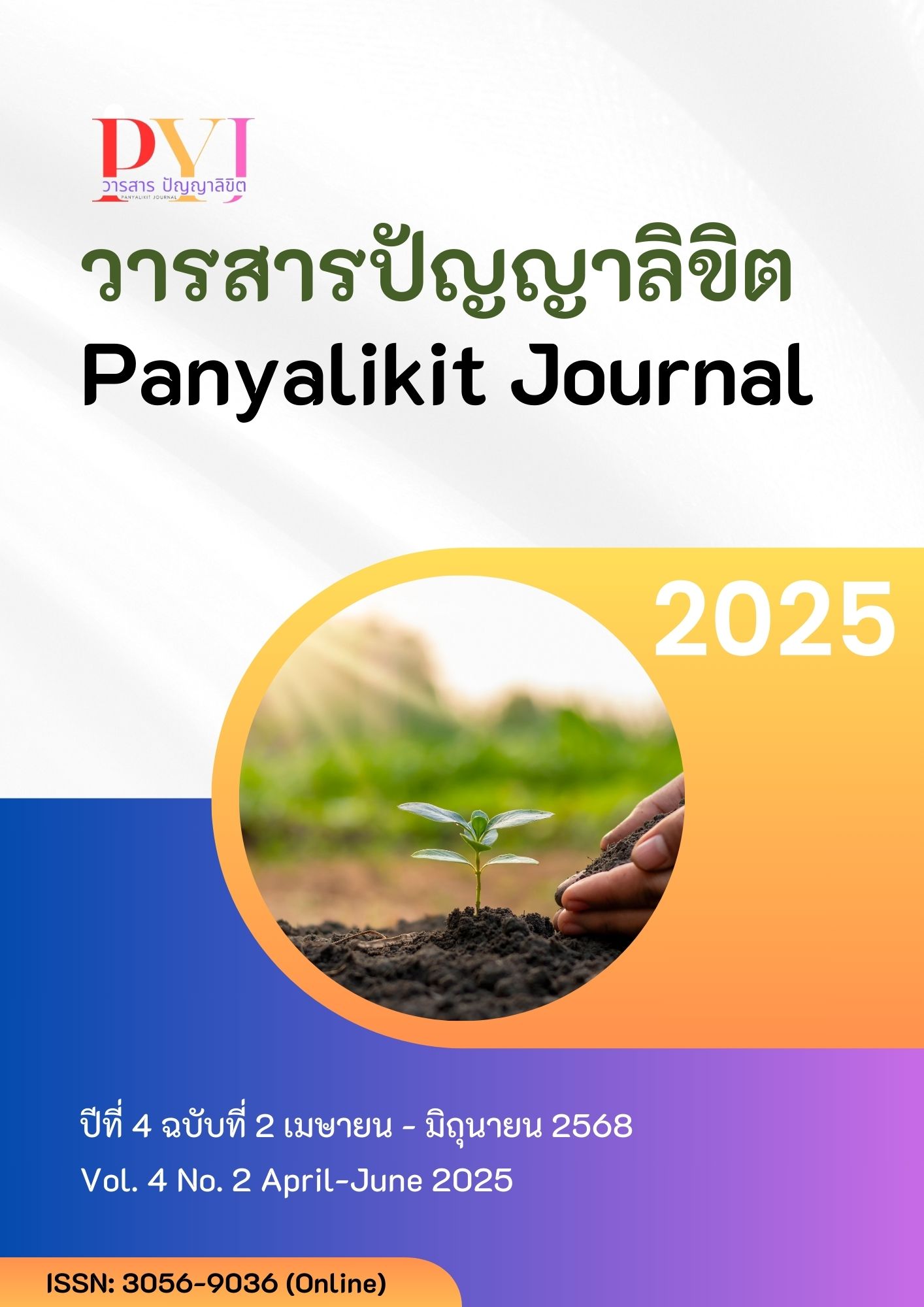Factors Affecting Innovative Leadership under the Nakhonnayok Primary Educational Service Area Office
Main Article Content
Abstract
The research aims 1) to factors affecting innovative leadership in the 21st century of school administrators 2) to the levels of transformational leadership, creativity, and administrative support factors 3) to study the relationship between transformational leadership, creativity, and administrative support factors with innovative leadership in the 21st century of school administrators; and 4) to create prediction equations for innovative leadership in the 21st century of school administrators. The sample consisted of 291 school administrators and teachers under Nakhonnayok Primary Educational Service Area Office, selected by stratified random sampling. The research instrument was a 5-level rating scale questionnaire. The statistics used for data analysis were mean (M), standard deviation (SD), Pearson's correlation coefficient, multiple regression analysis, and stepwise multiple regression analysis.
The research findings were as follows: 1) Factors affecting innovative leadership in the 21st century of school administrators included transformational leadership, creativity, and administrative support factors.
2) Overall and in each aspect, the levels of transformational leadership, creativity, and administrative support factors were at a high level. 3) Transformational leadership factors, creativity factors, and administrative support factors showed a positive correlation with innovative leadership in the 21st century of school administrators at a relatively high level overall and in each aspect. 4) The predictor variables could predict innovative leadership in the 21st century of school administrators in the following order: administrative support factors (X₃), creativity factors (X₂), and transformational leadership factors (X₁), with a combined predictive power of 25.60%. The raw score prediction equation was:
Ŷ = 0.402(X₃) + 0.380(X₂) + 0.184(X₁), and the standardized score prediction equation was:
Ẑ = 0.325(Z₃) + 0.284(Z₂) + 0.178(Z₁)
Article Details

This work is licensed under a Creative Commons Attribution-NonCommercial 4.0 International License.
References
ศิวพร เสลาหลัก. (2559). การรับรู้ภาวะผู้นำการเปลี่ยนแปลง และความคิดสร้างสรรค์ ที่ส่งผลต่อประสิทธิผลการปฏิบัติงานเชิงนวัตกรรมของพนักงาน ธนาคารเพื่อการเกษตรและสหกรณ์การเกษตรสังกัดสำนักงานจังหวัดราชบุรี (วิทยานิพนธ์ศิลปศาสตรมหาบัณฑิต). มหาวิทยาลัยศิลปากร.
สมนึก เพชรช่วย และสมเดช สิทธิ์พงค์พิทยา. (2563). ภาวะผู้นำการเปลี่ยนแปลง การจัดการความรู้
องค์การแห่งการเรียนรู้ และพฤติกรรมการทำงานเชิงนวัตกรรมในโรงเรียนสังกัดสำนักงานพื้นที่การศึกษามัธยมศึกษา เขต 1,2,3,4,และ 6. วารสารสมาคมนักวิจัย, 22(1), 193-204.
สายรุ้ง แก้วมณี. (2565). บทบาทของความคิดสร้างสรรค์ในการส่งเสริมภาวะผู้นำเชิงนวัตกรรมในโรงเรียน. วารสารการศึกษาและนวัตกรรม, 8(4), 68-83.
Bass, B. M. & Riggio, R. E. (2006). Transformational leadership (2nd ed.). Mahwah, NJ: Lawrence Erlbaum Associates.
Doran, A. & Minton, S. (2024). Transformational leadership, leader support, and employee innovation: A comprehensive framework. International Journal of Innovation Management, 28(3), 321-339.
Emerald Insight. (22 June 2024). Organizational digital transformation: from evolution to future trends. Retrieved October 3, 2024, from https://www.emerald.com/insight/content/doi/10.1108/dts-08-2023-0061/full/html
Fullan, M. (2021). Leading in a culture of change: Innovation in educational leadership for the 21st century. San Francisco, CA: Jossey-Bass.
Krejcie, R.V. and Morgan, D.W. (1970) Determining Sample Size for Research Activities. Educational and Psychological Measurement, 30, 607-610.
Scott, S. G. & Bruce, R. A. (2023). Leader support and innovative outcomes: The role of creativity and risk-taking. Journal of Applied Psychology, 108(1), 145-157.
Szymanski, K. & Henard, D. H. (2024). The impact of creativity on innovative leadership in global organizations. International Journal of Innovation Management, 28(3), 305-324.
United Nations. (23 January 2024). The impact of digital technologies. Retrieved August 5, 2024, from https://www.un.org/en/un75/impact-digital-technologies
University of California Press. (5 May 2024). Technology and global change. Retrieved October 7, 2024, from https://online.ucpress.edu/collection/222/Technology-and-Global-Change
World Bank. (11 December 2023). Global migration in the 21st century: Navigating the impact of climate change, conflict, and demographic shifts. Retrieved May 6, 2024, from https://www.worldbank.org/en/news/feature/2023/12/11/global-migration-in-the-21st century-navigating-the-impact-of-climate-change-conflict-and-demographic-shifts

